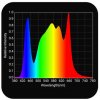Kassiopeija
Well-Known Member
my initial response got deleted before posting, I want to add that the second .pdf held a nice spec about water absorption (showing the depths)haha i knew you would pick em to bits...
imagine now algae adopting to all these various colors or specs, for 2.5bn years until life went onto land..
the one commentator is essentially right all of this is already known. but books that go very deep into it are costly and hard to comprehend. even alot of studies are skewed when they only show a very narrow "side if the story".







